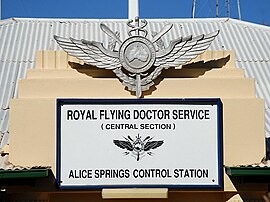Flying Doctor Service

Old RFDS logo at Alice Springs Base
|
|
| Abbreviation | RFDS |
|---|---|
| Predecessor | AIM Aerial Medical Service |
| Founder | Rev. John Flynn |
| Founded at | Cloncurry, Queensland |
| Type | Not-for-profit organisation |
| Legal status | Charity |
| Purpose | To provide excellence in aeromedical and primary health care across Australia |
|
Region
|
Australia |
| Services | Air ambulance |
|
Official language
|
English |
| Slogan | The Flying Doctor |
| Website | flyingdoctor |
The Royal Flying Doctor Service of Australia (RFDS, informally known as The Flying Doctor) is one of the largest and most comprehensive aeromedical organisations in the world. It provides emergency and primary health care services for those living in rural, remote and areas of Australia. It is a not-for-profit organisation which provides health care to people who cannot access a hospital or general practice due to the vast distances of the Outback.
The Reverend John Flynn had worked in rural and remote areas of Victoria and was commissioned by the Presbyterian Church to look at the needs of Outback people. His report to the Presbyterian Assembly in 1912 resulted in the establishment of the Australian Inland Mission (AIM), of which he was appointed Superintendent. In 1928, he formed the AIM Aerial Medical Service, a one-year experiment based in Cloncurry, Queensland. This experiment later became The Royal Flying Doctor Service.
Flynn's missionary work involved the establishment of hospitals in bush communities. This, however, did not help those who lived far from any major community. In his public speaking he would often retell the tragic circumstances that had befallen several bush settlers. The fate of Jimmy Darcy, in 1917, was one of these stories.
It was from stories such as this that Flynn, and his following at the AIM, became inspired to develop a route of communications that could solve the problem of remoteness. However, no feasible technology seemed apparent.
Victorian pilot Lieutenant (John) Clifford Peel had heard Flynn's public speeches, and on being shipped out to France for World War I in 1917, sent Flynn a letter explaining how he had seen a missionary doctor visiting isolated patients using a plane. Assisted by costing estimates by Peel, Flynn immediately took the idea of using aircraft to begin his idea, and published Peel's idea in the church's newsletter. Peel died in combat in September 1918, probably not even knowing the impact he had in the creation of an Australian icon.
Along with motorised flight, another new technology was being developed that could replace the complicated means of communication by telegraph. Together with Alfred Traeger, Flynn began experiments with radio in the mid-1920s to enable remote outposts to contact a centralised medical base. The pedal radio was the first result of this collaboration. These were distributed gradually to stations, missions and other human residences around Cloncurry, the base site for a 50-watt transmitter.
...
Wikipedia
